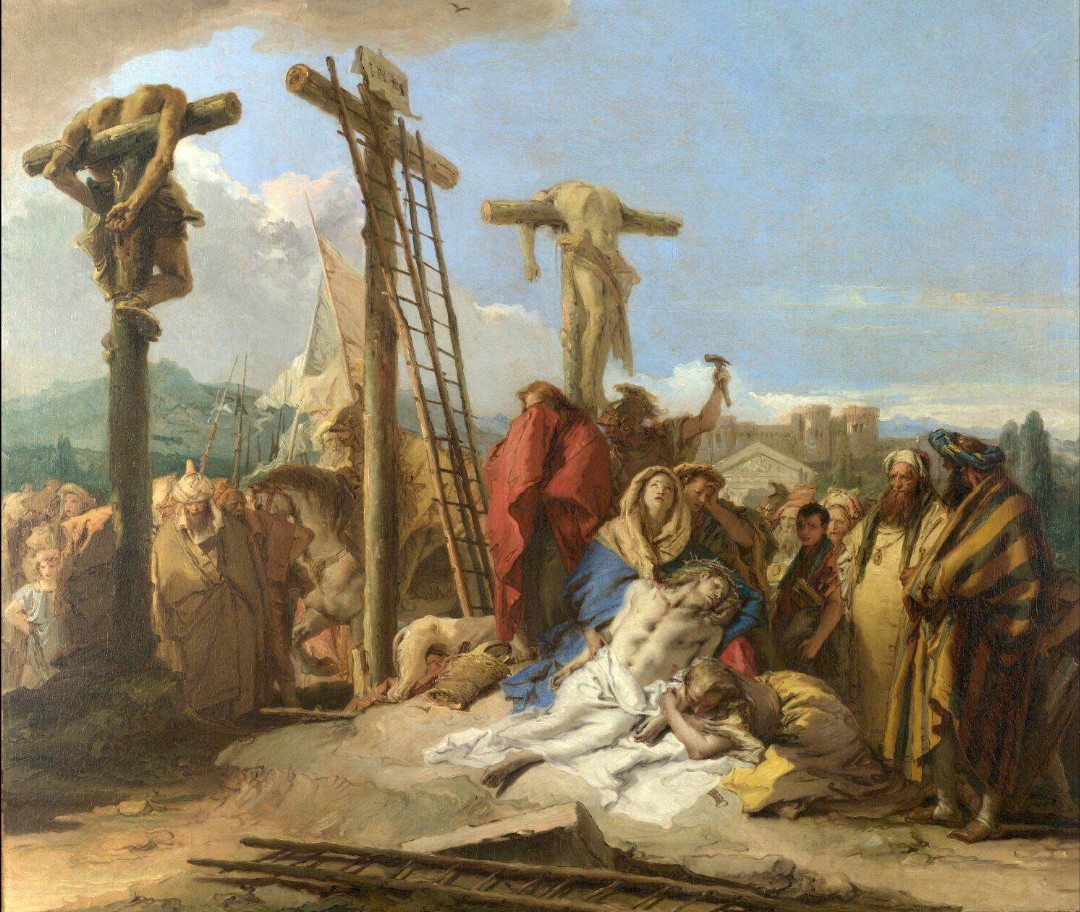
One of the most popular legends argues that Joseph brought the Holy Grail (the cup from the Last Supper) and hid it in a Glastonbury well, now called the Chalice Well. This legend stems from French poet Robert de Boron’s verse romance called Joseph d’Arimathie (1200). In this poem, Joseph is entrusted with the Holy Grail, and imprisoned in Jerusalem by the Jewish elders after they realize he had removed Jesus’ body from the cross. However, upon his release, rather than returning to Arimathea, Joseph gathers a company of followers who take the Grail to Britain.
Other, later poems also make similar claims. In the subsequent romance Perlesvaus (an Old French Arthurian romance, 13th century), it is said that Joseph travels to Britain with relics. This vast Arthurian composition took much inspiration from de Boron, but in this telling, it is not just Joseph who is considered the primary holy man of Britain, but his son Josephus as well.
Joseph of Arimathea was, according to all four canonical gospels, the man who assumed responsibility for the burial of Jesus after his crucifixion. The historical location of Arimathea is uncertain, although it has been identified with several towns. A number of stories that developed during the Middle Ages connect him with Glastonbury, England and also with the Holy Grail legend.
Matthew 27 (Matthew 27:57) describes him simply as a rich man and disciple of
Jesus
Christ, but according to Mark 15 (Mark 15:43) Joseph of Arimathea was "a respected member of the council, who was also himself looking for the kingdom of God". Luke 23 ( Luke 23:50–56) adds that he "had not consented to their decision and action".
According to John 19 (John 19:38), upon hearing of Jesus' death, this secret disciple of Jesus "asked Pilate that he might take away the body of Jesus, and Pilate gave him permission." Joseph immediately purchased a linen shroud (Mark 15:46) and proceeded to Golgotha to take the body of Jesus down from the cross. There, according to John 19:39-40, Joseph and Nicodemus took the body and bound it in linen cloths with the spices (myrrh and aloes) that Nicodemus had brought. Luke 23:55-56 states that the women "who had come with him from Galilee" prepared the spices and ointments.
The disciples then conveyed the prepared corpse to a man-made cave hewn from rock in a garden nearby. The Gospel of Matthew alone suggests that this was Joseph's own tomb (Matthew 27:60). The burial was undertaken speedily, "for the Sabbath was drawing on".
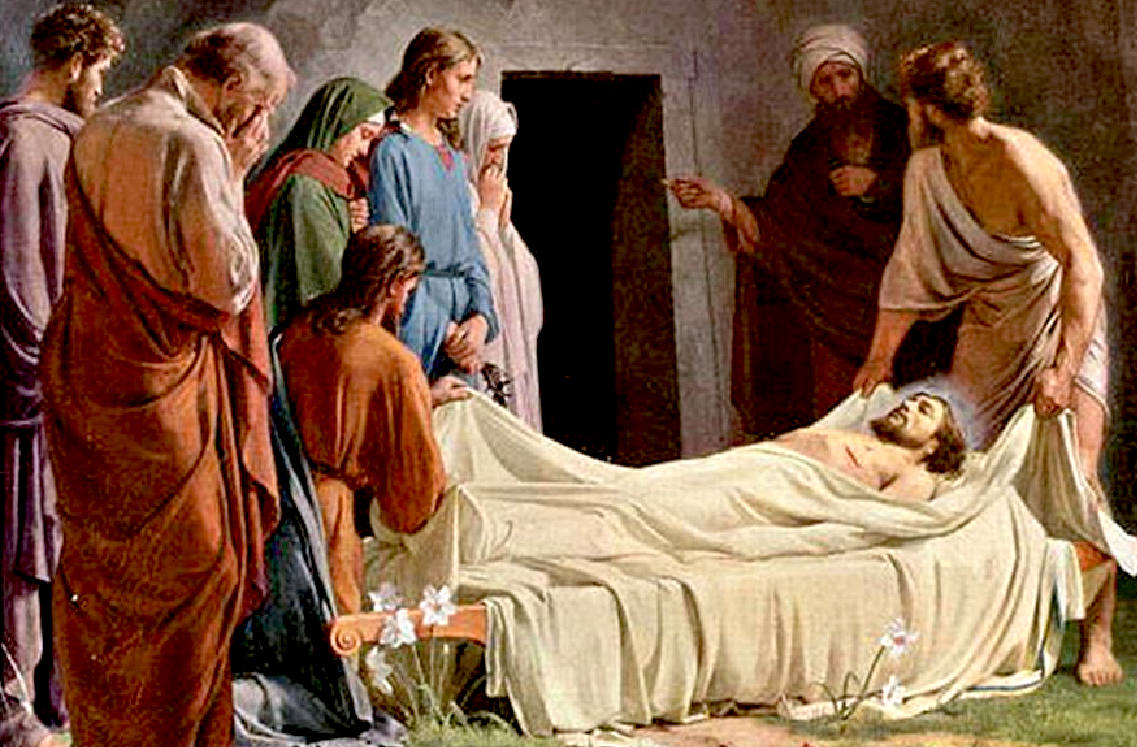
The Origins of the Holy Thorn of Glastonbury
- There is a variety of hawthorn that flowers twice a year in spring and in winter - or if the temperature is right, Easter and Christmas in Britain. Legend states that after the death of Jesus, Joseph of Arimathea became a missionary. He was eventually sent to England where he was ordered to preach the Gospel. With him, he took the Holy Grail, as well as his pilgrim’s staff. Once he arrived in England, he traveled to Glastonbury in what is now Somerset.
There, at Wearyall Hill, he struck his staff on the ground and by the next morning, it had turned into a flowering thorn tree. Joseph then proceeded to convert thousands to Christianity. This included normal, everyday English people, as well as the local king Ethelbert. Joseph did not stop there, however, and it is said he went on to found Glastonbury Abbey .
Joseph became so famous and respected that upon his death at age 86, legend states that his body was carried by six kings in the funeral procession. To this day it is said that the Glastonbury Thorn flowers every year on Christmas Day. It is also said that a hawthorn plant in the churchyard of St John’s Church in Glastonbury blossoms and is used to decorate the Christmas breakfast table of the Queen of England every year.
DEVELOPMENT OF THE LEGEND
Since the 2nd century, a mass of legendary detail has accumulated around the figure of Joseph of Arimathea in addition to the New Testament references. Joseph is referenced in apocryphal and non-canonical accounts such as the Acts of Pilate and the medieval Gospel of Nicodemus. Joseph is mentioned in the works of early church historians such as Irenaeus, Hippolytus, Tertullian, and Eusebius, who added details not found in the canonical accounts. Francis Gigot, writing in the Catholic Encyclopedia, states that "the additional details which are found concerning him in the apocryphal Acta Pilati ("Acts of Pilate"), are unworthy of credence." The Narrative of Joseph of Arimathea, a medieval work, is even purportedly written by him directly, although it adds more details on the robbers at Jesus's crucifixion than Joseph himself. He also appears in the ancient non-canonical text the Gospel of Peter.
Hilary of Poitiers (4th century) enriched the legend, and John Chrysostom, the Patriarch of Constantinople from 397 to 403, was the first to write that Joseph was one of the Seventy Apostles appointed in Luke 10.
During the late 12th century, Joseph became connected with the Arthurian cycle, appearing in them as the first keeper of the Holy Grail. This idea first appears in Robert de Boron's Joseph d'Arimathie, in which Joseph receives the Grail from an apparition of Jesus and sends it with his followers to Britain. This theme is elaborated upon in Boron's sequels and in subsequent
Arthurian works penned by others. Later retellings of the story contend that Joseph of Arimathea travelled to Britain and became the first Christian bishop in the Isles, a claim Gigot characterizes as a fable.
HOW DID CHRISTIANITY ENTER BRITAIN?
Many legends about the arrival of Christianity in Britain abounded during the Middle Ages. Early writers do not connect Joseph to this activity, however. Tertullian wrote in Adversus Judaeos that Britain had already received and accepted the Gospel in his lifetime, writing, "all the limits of the Spains, and the diverse nations of the Gauls, and the haunts of the
Britons - inaccessible to the Romans, but subjugated to Christ."
William of Malmesbury's De Antiquitate Glastoniensis Ecclesiae ("On the Antiquity of the Church of Glastonbury", circa 1125) has not survived in its original edition, and the stories involving Joseph of Arimathea are contained in subsequent editions that abound in interpolations placed by the Glastonbury monks "in order to increase the Abbey's prestige – and thus its pilgrim trade and prosperity." In his Gesta Regum Anglorum (History of The Kings of England, finished in 1125), William of Malmesbury wrote that Glastonbury Abbey was built by preachers sent by Pope Eleuterus to Britain, however also adding: "Moreover there are documents of no small credit, which have been discovered in certain places to the following effect: 'No other hands than those of the disciples of
Jesus
Christ erected the church of Glastonbury'", but here William did not explicitly link Glastonbury with Joseph of Arimathea, but instead emphasizes the possible role of Philip the Apostle: "if Philip, the Apostle, preached to the Gauls, as Freculphus relates in the fourth chapter of his second book, it may be believed that he also planted the word on this side of the channel also."
In 1989 A. W. Smith critically examined the accretion of legends around Joseph of Arimathea, by which the poem hymn of William Blake And did those feet in ancient time is commonly held as "an almost secret yet passionately held article of faith among certain otherwise quite orthodox Christians" and Smith concluded "that there was little reason to believe that an oral tradition concerning a visit made by Jesus to Britain existed before the early part of the twentieth century". Sabine Baring-Gould recounted a Cornish story how "Joseph of Arimathea came in a boat to Cornwall, and brought the child Jesus with him, and the latter taught him how to extract the tin and purge it of its wolfram. This story possibly grew out of the fact that the Jews under the Angevin kings farmed the tin of Cornwall." In its most developed version, Joseph, a tin merchant, visited Cornwall, accompanied by his nephew, the boy Jesus. Reverend C.C. Dobson (1879–1960) made a case for the authenticity of the Glastonbury legenda. The case was argued more recently by the Church of Scotland minister Dr Gordon Strachan (1934–2010) and by the former archaeologist Dennis Price.
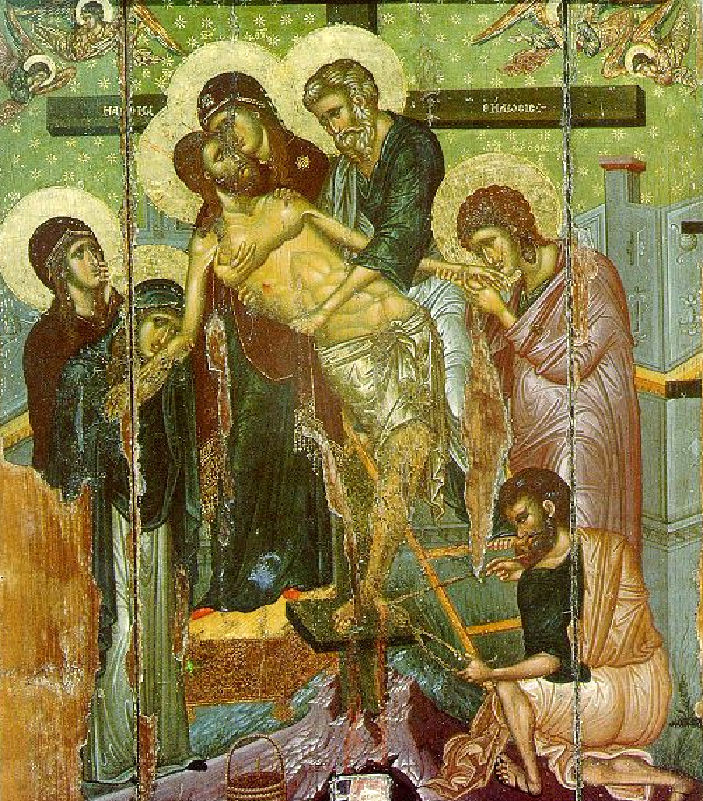
HOLY GRAIL
The legend that Joseph was given the responsibility of keeping the Holy Grail was the product of Robert de Boron, who essentially expanded upon stories from Acts of
Pilate. In Boron's Joseph d'Arimathe, Joseph is imprisoned much as in the Acts of Pilate, but it is the Grail that sustains him during his captivity. Upon his release he founds his company of followers, who take the Grail to Britain, though Joseph does not go. The origin of the association between Joseph and Britain is not entirely clear, though in subsequent romances such as Perlesvaus, Joseph travels to Britain, bringing relics with him. In the Lancelot-Grail cycle, a vast Arthurian composition that took much from Robert, it is not Joseph but his son Josephus who is considered the primary holy man of Britain.
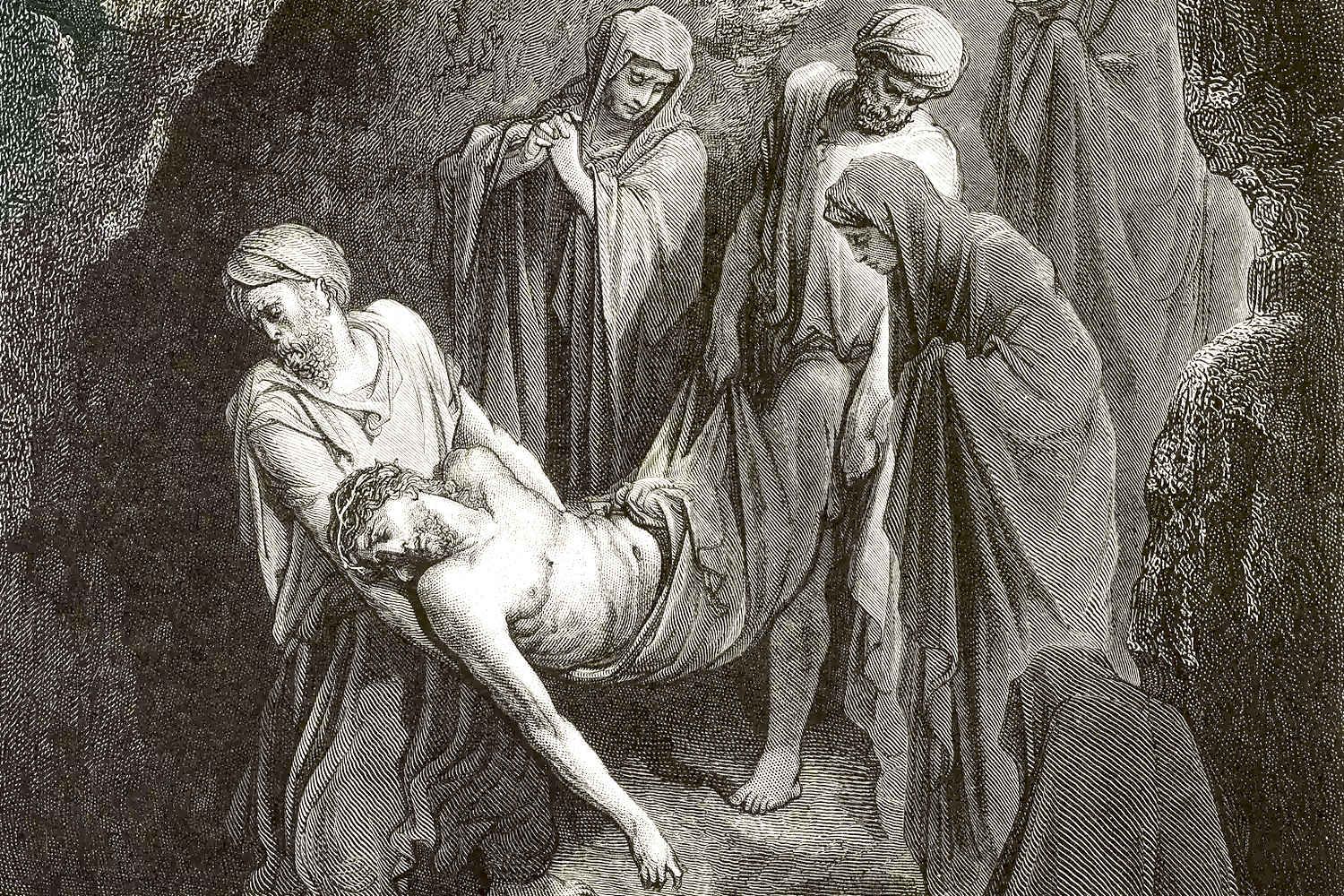
Joseph
of Arimathea conveys Jesus for burial
Later authors sometimes mistakenly or deliberately treated the Grail story as truth. Such stories were inspired by the account of John of Glastonbury, who assembled a chronicle of the history of Glastonbury Abbey around 1350 and who wrote that Joseph, when he came to Britain, brought with him vessels containing the blood and sweat of Christ (without using the word Grail). This account inspired the future claims of the Grail, including the claim involving the Nanteos Cup on display in the museum in Aberystwyth. There is no reference to this tradition in ancient or medieval text. John of Glastonbury further claims that King Arthur was descended from Joseph, listing the following imaginative pedigree through King Arthur's mother:
Helaius, Nepos Joseph, Genuit Josus, Josue Genuit Aminadab, Aminadab Genuit Filium, qui Genuit Ygernam, de qua Rex Pen-Dragon, Genuit Nobilem et Famosum Regum Arthurum, per Quod Patet, Quod Rex Arthurus de Stirpe Joseph descendit.
Elizabeth I cited Joseph's missionary work in England when she told Roman Catholic bishops that the Church of England pre-dated the Roman Church in England.
The quest to
find the Holy Grail, Cup of Jesus
Christ, is a search for the divine in all of us.
The Holy Grail (French: Saint Graal, Breton: Graal Santel, Welsh: Greal Sanctaidd, Cornish: Gral) is a treasure that serves as an important motif in Arthurian literature.
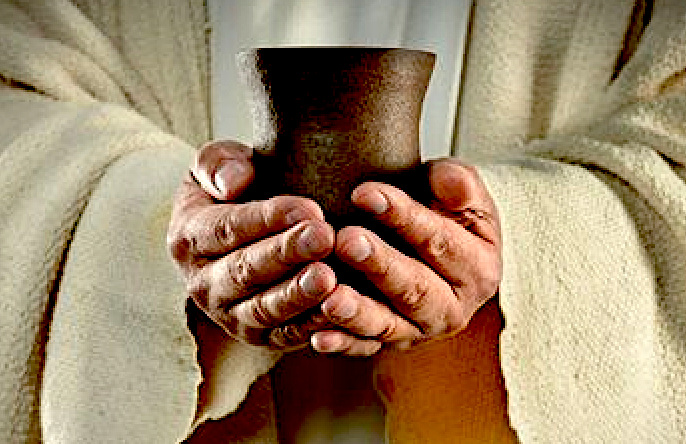
The
Cup of Christ is the Holy Grail, that has never been found.




